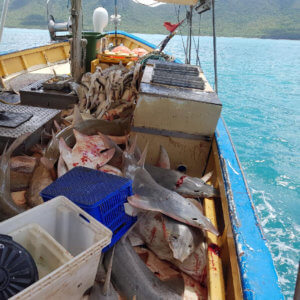Gillnet fishers in our Great Barrier Reef are hugely under-reporting the deaths of threatened and endangered species like dugongs, dolphins, turtles and sawfish which get entangled in their nets, the Australian Marine Conservation Society has found.
Using the numbers of entanglements reported by independent fisheries observers, AMCS conservatively estimates that in 2019, 30 dugongs, 30 dolphins, 1066 turtles and 1888 sawfish were caught in the Queensland East Coast gillnet fishery. And yet fishers officially reported bycatch of just three dugongs, three dolphins, 10 turtles and 374 sawfish for the same period.

AMCS Great Barrier Reef Fisheries Campaign Manager Simon Miller said the huge disparity highlighted the need for urgent reform of Queensland's fisheries including getting cameras on all gillnet fishing boats to gain an accurate picture of the scale of wildlife deaths.
"The vast level of the under-reporting suggests the real story of carnage is being covered up to avoid bad publicity and prevent further reforms to Queensland's fisheries," said Mr Miller.
"All of these species are protected in Queensland waters and our Reef is a refuge for them. The World Heritage area should be a sanctuary for these species whose populations have crashed in other countries.
"This extraordinary area should be where we find the best fishing practices in the world, practices which work to protect marine wildlife not result in their painful deaths. But gillnets are indiscriminate killers invisible to threatened species like dugongs, who are easily entangled and drown within minutes.
"Fishers are legally required to report interactions with all protected species but it's clear they are not taking their responsibility to do so seriously. We need tougher rules and better monitoring to protect Reef wildlife."
Mr Miller said the Queensland government had recently closed consultation on a Protected Species Management strategy, which is intended to reduce interactions with endangered species in the gillnet fishery.
But he said the draft strategy would fail to ensure threatened species in our Reef are protected and ensure fishers are accurately reporting their interactions with them.
"We need to immediately get cameras on all gillnet fishing boats so we get the true picture of what's going on in the gillnet fishery and the public know the real cost of fishing on our Reef," said Mr Miller.
"We also need the Queensland government to set limits on the number of endangered species that can be caught in a region. If this number is caught, the area should be closed to fishing for a few years to allow the populations to recover.
"Sadly, for species like snubfin dolphins that are slow to reproduce, even the loss of a few individuals can have devastating impacts on populations and could lead to localised extinctions.
"Without these changes, the strategy would be a major policy fail for the Palaszczuk Government and a missed opportunity to reduce the numbers of threatened and endangered species being caught on our Reef. It will lead to the ongoing decline of iconic endangered species such as turtles and sawfish."
The AMCS and over 10,500 of its supporters wrote to the Queensland government urging them to improve the Protected Species Management strategy.
The final strategy is due to be released in the coming months.
Background
The bycatch estimates calculated by AMCS were based on the numbers of interactions seen by fisheries observers in the Queensland East Coast Inshore Fishery in the now defunct fishery observer program that ran between 2006 and 2012. In that period fisheries observers recorded the catch of threatened and endangered species in gillnets, spending 426 days at sea with commercial fishers. From these observed interactions, an interaction rate was calculated and extrapolated to the number of days fished in 2019 to get a conservative estimate of the number of threatened species that may have been caught.
Fisheries observers are used in Australian and International fisheries to provide independent verification of commercial fishing operations, providing accurate scientific data on the species assemblages that are being caught. The Queensland fishery observer program was scrapped by the Campbell Newman Government in 2013 and has not been reinstated.
Cameras on fishing vessels, known as electronic monitoring, is a modern alternative to fisheries observers that gives an accurate picture of fishing operations. Electronic monitoring is already in place in a number of Commonwealth managed fisheries in Australia.
Fishers in the East Coast Inshore Fishery lost their ability to export their products internationally, when the Commonwealth Government revoked the Wildlife Trade Operation (WTO) accreditation for the fishery in September 2020. The WTO revocation was partially due to the lack of independent verification of fishing operations in the fishery.






